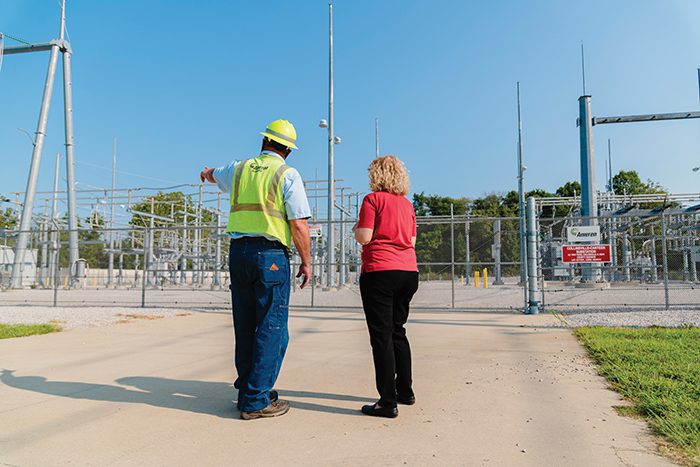Ensuring Power Grid Health Through Better Asset Management
The power sector has been evolving for years and technology has been instrumental in the change. Today, asset performance management and predictive maintenance tools can help power companies avoid outages, extend the lifespan of equipment, reduce operational costs, and improve safety.
It’s no secret that the energy business has been turned upside down over the past several years. Political change, market forces, and advancements in sustainable energy technology have knocked down most barriers to energy production at the edge of the network and in people’s homes. Producing power is no longer the primary focus of value creation for most electric utilities. Instead, we now find ourselves in the business of delivering power across an increasingly complex, dynamic electrical grid (Figure 1). Ameren, like many electric utilities, has turned our focus to being a customer-centric service provider.
 |
|
1. The electric power generation, transmission, and distribution system becomes more complex every day as new wind and solar resources are integrated into the grid. Courtesy: Hitachi Energy |
Lifelong utility veterans like myself are witnessing an unprecedented transformation in societal behavior, which is driving change to our utility business model. We’re conservative by nature, because that’s what is necessary to satisfy our mission to deliver safe, reliable, and secure energy to our customers. In the past, that meant building, owning, and operating centralized coal- and gas-powered plants. These provided the electricity that fueled America’s growing economy while delivering shareholder value unprecedented in economic history.
Those days are behind us. Wind, solar, geothermal, and tidal energy sources are not only the future, but also the present. Renewable energy provided 12% of the electrical energy consumed in the U.S. in 2020—a figure that will continue to grow in the years and decades ahead.
But It’s Not All Doom and Gloom
Bolstered by the push to convert gas-powered vehicles to electric vehicles, electricity usage will continue to grow. President Biden has announced that half of all new vehicles sold in the U.S. by 2030 will be electric. General Motors said it will phase out gas-powered cars by 2035. Mercedes-Benz, Volvo, and Daimler have made similar pronouncements while Ford released an electric version of the F-150 pickup truck. The switch to electric vehicles alone is predicted to increase electricity consumption by 25%.
The country’s power grid will handle these challenges, but it will require an investment by the power companies that own and operate these grids. Power generated on the edge of the network will need to be managed, modulated, and delivered on demand to wherever it is needed, across increasingly complex electrical infrastructure. Consumers expect to flip a switch and see the light. If the lights go off or the assembly line shuts down or the data center goes dark—that’s on us. And people will know it.
The biggest problem is the outdated business model of utilities. As we switch to a service-oriented business, we need to consider that traditional revenue streams are going away and margins are shrinking. It’s critical that utilities eke every bit of value out of our largest asset—the electrical grid. This can be done by proactively maintaining an electrical grid that is old, outdated, and getting increasingly more complex. Many transformers and other equipment are approaching 40 years old. These things were built to last—and many will be in the field for decades longer—but they need to be regularly maintained and their capacity managed. Unfortunately, an aging workforce means less onsite skill and experience within operations, maintenance, and engineering teams. It’s clear that the increasingly complex and dynamic nature of the grid is outpacing capabilities of human operators.
The Art of Doing More with Less
Doing more with less can be solved with innovative technology. Unfortunately, utilities do not have a culture of innovation to fall back on. We’ve spent the past 100 years maintaining the status quo, and we’re not going to all of a sudden become lean organizations with huge research and development groups. Instead, we need to partner with an industry that already has a culture of innovation—the high-tech sector.
Digital transformation powered by the scale and economics of the cloud is changing the way businesses operate. Companies as diverse as Walmart and Disney are using data to make evidence-based decisions instead of operating on gut feel. The result is business agility that allows employees to focus on customer experiences and respond quickly to market demands as they come up. We can take lessons from these use cases and create innovative solutions that will enable us to radically transform the electric utility.
Asset Management Can Truly Transform How Utilities Operate
Asset management is a great example of an innovative technology we can use to improve how we operate. The manufacturing industry uses the Internet of Things (IoT) and advanced networking to monitor, control, and optimize equipment on the factory floor. Logistics companies—who we have a lot in common with—use asset management to streamline supply lines, map out optimal routes, maintain fleets, and keep drivers safe. It’s not so hard to see how these innovations can be applied to the electrical grid.
 |
|
2. New technology, including artificial intelligence and machine learning, is making it easier to manage assets, ensuring the right maintenance is performed at the right time. Source: Shutterstock |
A robust and innovative asset management strategy can provide new insights into grid health and behavior. It can give us real-time awareness in the control room. And, using powerful artificial intelligence (AI) and machine learning (ML) algorithms, we can truly understand generation and consumption trends, and take proactive actions that make sense (Figure 2). Most importantly, we can automate the maintenance and upkeep of the grid in a cost-efficient, practical manner.
Back in 2017, my company made the decision to modernize the way we do business in preparation for the inevitable change we’d all been seeing. A team consisting of design engineers and folks from my digital organization were tasked with automating existing processes to enhance our asset management strategy. Very quickly, however, it was clear that it wasn’t enough to improve how we’d always done things. We had to throw everything out the window and completely change how we viewed our assets, our operations, and our business model. Thankfully, we found an excellent partner in Hitachi Energy.
Alongside them, we created a new asset management strategy, powered by AI and ML, that improved our operations and enabled us to transform into a new kind of energy company. Here are three ways we did it.
Proactively Avoid Outages. We are a customer-led business whose core mission is to ensure the lights stay on. It is critical that we know the health of our assets across the grid and how problems will impact our ability to deliver electricity. Monitors attached to our grid assets feed health and performance data to analytics engines powered by numerous statistical methods including AI and ML. This tells us the condition and the risk, giving operators the information they need to make critical decisions around maintenance and other actions they can take to proactively avoid outages. Preventing critical asset failures before they occur is key to success in a business climate of ever-increasing customer expectations.
Extend Lifespan of Equipment. Operators can apply the same condition and risk information they use to avoid outages to extend the lifespan of assets by managing maintenance and upgrades in a smarter, more intelligent way. Instead of scheduling regular maintenance once a month or once a year, for example, we can use real data from the assets themselves to determine when they need some attention. This reduces operational costs without increasing risk of failure. Extending the life of assets while lowering the cost of maintenance allows us to invest in other areas for increased reliability and flexibility while keeping prices affordable.
Reduce Operational Costs and Improve Safety. Only maintaining assets when they need attention allows us to switch from a preventive maintenance strategy to a condition-based maintenance strategy. This massively reduces maintenance trips, saving a lot of money while keeping our workers safer. Catastrophic failures often occur in the middle of the night or on the weekend, leading to overtime while placing technicians in less familiar work settings. Eliminating these catastrophic failures reduces operational costs and improves worker safety.
It’s Time to Innovate Our Way Through Great Change
Changes to the power industry well beyond our control will require a new culture of innovation at utilities across the country. It’s critical that we partner with technology companies that have a track record of transforming other industries to better compete in a modern world.
Asset performance management powered by AI and ML can provide new insights into grid health and behavior, helping us better understand generation and consumption trends, and take proactive actions, while automating the maintenance and upkeep of the grid. I want to say that change is coming, but, in all honesty, it’s already here. It’s time to embrace these new, innovative technologies to deliver on our promise to customers well into the 21st century.
—Keith Hock is senior director of IT/OT, Digital Field Services, and Innovation for Ameren, a Fortune 500 electrical utility operating in Missouri and Illinois.